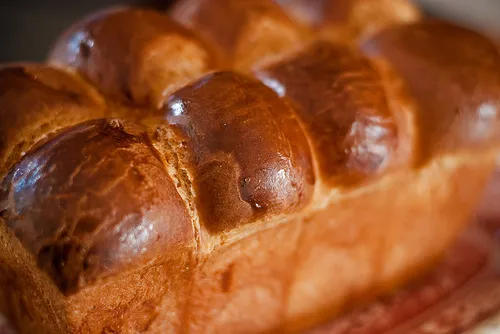
I've applied here instructions for a classic Brioche Nanterre. This specific brioche is baked in a loaf pan with 8 individual portions which are brilliant for setting at a tea service to be easily pulled apart. This loaf does break from convention in that it is egg washed twice. Once before rising and the second before going into the oven. This creates a richer and more luxurious color as well as shine. I also break up the ingredients list in to three sections consisting of;
Pre-Ferment (Poolish)
Main Dough
Egg Wash
This is to clarify the repetition of ingredients. Best of luck in your baking and may the odds be forever in your favor.
Summary
| Yield | 4- 800g Loaves |
|---|---|
| Prep Time | 15 Minutes |
| Baking Time | 40 Minutes |
| Steam | Optional |
Ingredients
300 g Whole milk (Poolish)
65 g Fresh Yeast (Poolish)
300 g Bread Flour (Poolish)
750 g Eggs (Main Dough)
1200 g Bread Flour (Main Dough)
60 g Sugar (Main Dough)
19 g Sea Salt (Main Dough)
750 g Unsalted butter (Main Dough)
50 g Eggs (Egg Wash)
5 g Whole milk (Egg Wash)
1 ds Salt (Egg Wash)
Instructions
Pre- Ferment (Poolish)
1. Combine 300g Whole Milk, 65g Fresh Yeast and 300g Bread Flour. Mix until a batter forms and allow to rise at room temperature until the center falls in upon itself.
Main Dough
1. In a stand mixer combine 1200g Bread Flour, 60g Sugar, 19g Salt and 750g Eggs.
2. Begin mixing on low speed gradually incorporating the poolish until a mass forms.
3. Once the ingredients are combined raise mixing speed to medium-high (5 or 6 on Kitchenaid) and let mix for 5 minutes.
4. Gradually incorporate 750g of cubed room temperature butter in to the mass, mixing at a high speed until the dough releases it's self from the bowl.
5. Check temperature of dough which should ideally be 22-23C. Any higher and the butter will separate from the mass and create a greasy end product.
6. Remove dough from mixing bowl and cover with plastic wrap. Place bowl in 4C refrigerator overnight.
7. The next day, remove dough from bowl and cut in to 4- 800g balls. From this point shaping is up to you, however for the Nanterre shape one must cut each ball in to a further 8-100g pieces.
8. Gently round the balls and place in a lightly buttered loaf pan. Each loaf should consist of 8-100g balls arranged symmetrically in the pan.
9. For the egg wash; beat together 50g Eggs, 5g Whole Milk and a dash of salt.
10. Egg wash formed loaves
11. Cover in a plastic bag and allow to proof until risen roughly 1/2 inch above loaf tin tops. This will take about 1.5 - 2 hours.
12. Pre-heat oven to 380F.
13. Remove proofed loaves from bag and egg wash a second time making sure to evenly apply the glaze. Place in pre-heated oven and bake for 37-40 minutes. The loaves should be a rich mahogany color. To check the doneness of the loaf stick a small pairing knife in to the center and pull it out after a few seconds. If the knife is clean of batter it's done. Alternately you can check the internal temperature with a thermometer which will read over 205F.
14. Pull loaves from oven and unmould immediately. At this point you can glaze the loaf if you wish with any topping of your choosing. Some options are;
Melted jam, marmalade or jelly diluted with water to a point that it can be applied freely.
Sugar syrup, equal parts water and sugar.
Apricot glaze, diluted if necessary.
Warmed wild honey, diluted in water
Once glazed many chefs may take the liberty to add a further garnish and this of course up to the creator's inclination.
Some options that would also work fashionably are;
Streusel, equal parts flour, sugar and butter.
Pearl Sugar or another coarse sugar.
Cocoa Nibs, Shaved Chocolate.
Candied Fruit.
Fresh Berries, arranged and dusted with icing sugar.
Candied or Fresh Flower Petals, such as violet or rose.
Additional Notes
For the poolish a rule that applies to sweet bread baking is the 54 law.
The 54 law means that the liquid temperature, the room temperature and the flour temperature should all add up to 54C.
For example,
Your room temperature is 25C
The flour temperature is 15C
The liquid temperature would be x+(25+15)=54 x=54-30 so the liquid temperature would be 15C
This rule is completely unnecessary in a home kitchen however I thought I would include it for the more astute bakers.
- Brokeback Cowboy's Blog
- Log in or register to post comments
Excellent looking Brioche. Not a bread that is posted that much so thanks for the visual and formula.
Happy baking.
John